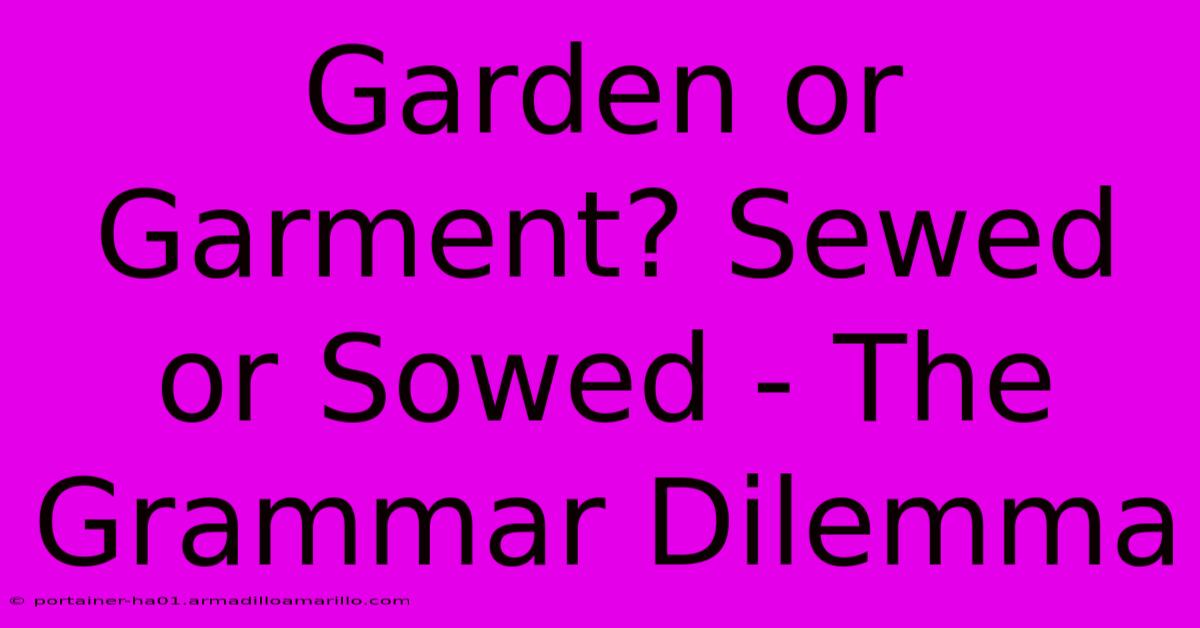Garden Or Garment? Sewed Or Sowed - The Grammar Dilemma

Table of Contents
Garden or Garment? Sewed or Sowed - The Grammar Dilemma
Many people stumble over the words "sew" and "sow," often confusing their meanings and misusing them in sentences. This seemingly simple grammatical dilemma actually highlights a fascinating distinction between two very different activities: creating clothing and cultivating plants. Let's delve into the nuances of these verbs and clear up this common confusion.
Understanding the Difference: Sew vs. Sow
At their core, "sew" and "sow" are homophones – words that sound alike but have different meanings and spellings. The key lies in their origins and historical usage.
Sew: The Art of Stitching
Sew refers to the act of joining fabrics or other materials using a needle and thread. This verb is firmly rooted in the realm of textiles and garment making. Think of tailors, seamstresses, and crafters meticulously stitching together pieces of cloth to create beautiful garments, quilts, or other sewn items.
Examples:
- "I'm going to sew a new dress for the party."
- "She learned to sew from her grandmother."
- "The tailor expertly sewed the tear in my jacket."
- "The past tense of sew is sewed" and its past participle is also sewed
Sow: Planting Seeds for the Future
Sow, on the other hand, is related to agriculture and the planting of seeds. It involves scattering or placing seeds in the ground to cultivate crops. This verb evokes images of farmers preparing the land and nurturing the growth of plants.
Examples:
- "Farmers sow their seeds in the spring."
- "She carefully sowed the flower seeds in the prepared soil."
- "He sowed the wheat and hoped for a bountiful harvest."
- "The past tense of sow is sowed" and its past participle is sown.
Common Mistakes and How to Avoid Them
The most frequent error occurs when people mistakenly use "sow" when they mean "sew," or vice-versa. This often results in sentences that are grammatically incorrect and semantically nonsensical.
Incorrect: "I'm going to sow a new dress." (This implies planting a dress in the ground!)
Correct: "I'm going to sew a new dress."
Incorrect: "The farmer sewed the seeds." (This pictures the farmer stitching seeds together!)
Correct: "The farmer sowed the seeds."
Remembering the Difference: Helpful Mnemonics
To help you remember the difference, consider these mnemonic devices:
- Sew: Think of the "e" in "sew" as representing the "eye" of the needle.
- Sow: Think of the "o" in "sow" as representing the "o" in "soil" or "open field" where seeds are planted.
Mastering the Nuances: Enhancing Your Writing
By understanding the subtle yet significant differences between "sew" and "sow," you can significantly enhance the clarity and accuracy of your writing. Avoiding this common grammatical error demonstrates attention to detail and a strong command of the English language.
Conclusion: A Stitch in Time Saves Nine (and Clears Up Confusion!)
The distinction between "sew" and "sow" may seem trivial at first glance, but mastering this grammatical detail demonstrates a refined understanding of language. By paying attention to the context and remembering the core meanings of these verbs, you can confidently use them correctly, ensuring your writing is both accurate and engaging. So, whether you're discussing a beautifully sewn garment or a carefully sown field, you'll be able to express yourself with precision and clarity.

Thank you for visiting our website wich cover about Garden Or Garment? Sewed Or Sowed - The Grammar Dilemma. We hope the information provided has been useful to you. Feel free to contact us if you have any questions or need further assistance. See you next time and dont miss to bookmark.
Featured Posts
-
Prepare For A Royal Affair Your Invitation To The Exclusive Disney Movie Court
Feb 07, 2025
-
Astonishing Revelations Jotun Price 2024 Set To Reshape The Industry
Feb 07, 2025
-
The Visual Alchemy Of Text Alignments Role In Design Magic
Feb 07, 2025
-
From Virgin Islands To Your Home Indulge In The Heavenly Scent Of Dnd Coconut Silk
Feb 07, 2025
-
Chicharito And The Beast The Most Outlandish Nicknames In Football
Feb 07, 2025
